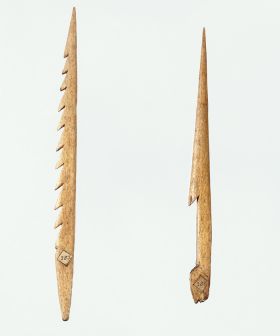Harpoon or lance point
Place: Tierra del Fuego
Category: Fishing & hunting
Harpoon or lance point, bone, possibly whalebone, Tierra del Fuego, l. 29 cm, w. 2.4 cm, Inv. Am 47 (right)
Harpoon or lance point, Yaghan or south-eastern Ona (Haus)
Humphrey No. 284: ‘another [Head or point of a fish-spear], with only one barb, also made of bone, from Terra del fuego.’
A long, slender point, blunt at the (somewhat tapered) rear end, has been made from a piece of whalebone by grinding with pieces of sandstone or pumice stone. A piece in the shape of a parallelogram has been cut out of one side near the end to make a barb, while the lower end is nearly rectangular.
Humphrey designated this object as the point of a fish spear. Similarly, G. Forster (1966, II: 382) described the spears of the Yaghan as serving ‘merely the catching of fish’, while noting that on the first voyage, they were seen to be used for the removal of mussels from underwater cliffs. On the second voyage, Cook and Clerke noted that the Yaghan had harpoons or long spears with bone points and wooden shafts. They presumed that these were used for hunting seals or catching fish, and perhaps also for whaling (Beaglehole 1969, II: 597, 764). In fact, the Ona used similar points of varying sizes as fish spears, sea lion lances, and as harpoons for the sea lion hunt (Gusinde 1931-75, I: 244-46). Sea lion lances and harpoons corresponded to those of the Yaghan (Gusinde 1931-75, II: 470-77, Fig. 33, 35; Lovisato 1883: 7, Fig. 4, 15; Heger 1884: 32-33, Fig. 36; Hyades and Deniker 1891: 353, PI. 31, Fig. 6, 7; Zeller 1909; Tab. II, Fig. 8, 11f., Cooper 1917: 205-07), and in the case of the Ona were present only among the Haus, in whose territory Cook landed on his first voyage. Forster (1966, II: 382) gave the length of the barbed bone points seen among the Yaghan as about twelve inches (c. 30 cm). This was within the range of point lengths for the ‘small harpoons’, whereas shorter points were often used for the ‘large harpoons’ (Gusinde 1931-75, II: 472, 475, 477). The fish spears of the Yaghan often had wooden points, or were fitted with two serrated bone points (Gusinde 1931-75, II: 477-79, Fig. 37). In the case of the Ona lances, the end of the point was clamped into a notch of the (at least 180 cm long) wooden shaft and wrapped in narrow leather straps. The hunters would creep up to the sleeping sea lions and ram the lance into the body. Once weakened by the loss of blood, the animal could be killed using a stone or a wooden club (Gusinde 1931-75, I: 245f.). The shafts of the Yaghan harpoons were about three metres long. They differed from the lances in having a removable point, which in the ‘small harpoons’ remained connected to the shaft by a short line, whereas the lines of the ‘large harpoons’ were twenty metres or more in length (Gusinde 1931-75, II: 471, 474f.). Christian F. Feest
Sources
Beaglehole, John Cawte, The Journals of Captain James Cook on his Voyages of Discovery. The Voyage of the Resolution and Discovery 1772–1775, Hakluyt Society, Extra Series, 35, Cambridge University Press, Cambridge, 1969 [1961, II].
Cooper, John M, Analytical and Critical Bibliography of the Tribes of Tierra del Fuego and Adjacent Territory, Bulletin 63, Bureau of American Ethnology, Smithsonian Institution, Washington, DC, 1917.
Forster, Georg, Reise um die Welt, 2 Teile, George Forsters Werke (2 und 3) Samtliche Schriften, Tagebücher, Briefe, hrsg. von der Akademie der Wissenschaften der DDR, Berlin 1966.
Gusinde, Martin, Die Feuerland-Indianer, 1: Die Selk’nam. 2: Die Yamana. 3/1: Die Halakwulup. 3/2: Anthropologie der Feuerland-Indianer, Mödling bei Wien, 1931-1975.
Heger, Franz, ‘Ethnographische Gegenstände von den Feuerländern’, Mitteilungen der Anthropologischen Gesellschaft in Wien, Sitzungsberichte, 1884, vol. 14, pp. 31-33.
Hyades, P and Deniker, J, Mission Scientifique du Cap Horn, 1882-1883, vol. VII: Anthropologie. Ethnologie, Paris, 1891.
Lovisato, Domenico, ‘Di alcune armi e utensili die fueghini, e degli antichi patagoni’, Reale Accademia dei Lincei, 1883, vol. 280, ser. 3, p. 11.
Zeller, Rudolf, ‘Beiträge zur Ethnographie der Feuerländer’, in Jahresberichte des Historischen Museums in Bern, 1909, pp. 75-91.
Related artefacts
Harpoon point kaheita, Inv. Am 643

